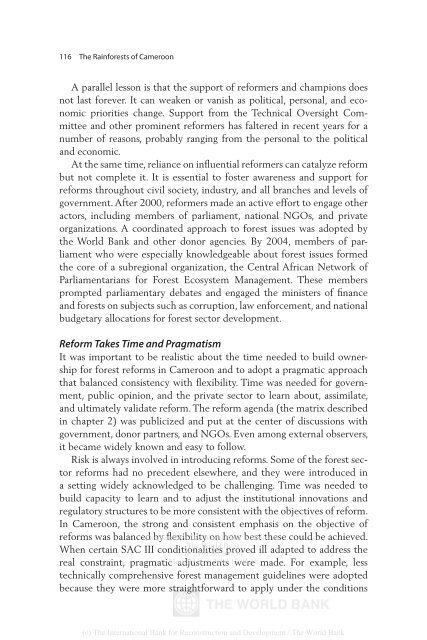The Rainforests of Cameroon - PROFOR
The Rainforests of Cameroon - PROFOR
The Rainforests of Cameroon - PROFOR
- No tags were found...
Create successful ePaper yourself
Turn your PDF publications into a flip-book with our unique Google optimized e-Paper software.
116 <strong>The</strong> <strong>Rainforests</strong> <strong>of</strong> <strong>Cameroon</strong>A parallel lesson is that the support <strong>of</strong> reformers and champions doesnot last forever. It can weaken or vanish as political, personal, and economicpriorities change. Support from the Technical Oversight Committeeand other prominent reformers has faltered in recent years for anumber <strong>of</strong> reasons, probably ranging from the personal to the politicaland economic.At the same time, reliance on influential reformers can catalyze reformbut not complete it. It is essential to foster awareness and support forreforms throughout civil society, industry, and all branches and levels <strong>of</strong>government. After 2000, reformers made an active effort to engage otheractors, including members <strong>of</strong> parliament, national NGOs, and privateorganizations. A coordinated approach to forest issues was adopted bythe World Bank and other donor agencies. By 2004, members <strong>of</strong> parliamentwho were especially knowledgeable about forest issues formedthe core <strong>of</strong> a subregional organization, the Central African Network <strong>of</strong>Parliamentarians for Forest Ecosystem Management. <strong>The</strong>se membersprompted parliamentary debates and engaged the ministers <strong>of</strong> financeand forests on subjects such as corruption, law enforcement, and nationalbudgetary allocations for forest sector development.Reform Takes Time and PragmatismIt was important to be realistic about the time needed to build ownershipfor forest reforms in <strong>Cameroon</strong> and to adopt a pragmatic approachthat balanced consistency with flexibility. Time was needed for government,public opinion, and the private sector to learn about, assimilate,and ultimately validate reform. <strong>The</strong> reform agenda (the matrix describedin chapter 2) was publicized and put at the center <strong>of</strong> discussions withgovernment, donor partners, and NGOs. Even among external observers,it became widely known and easy to follow.Risk is always involved in introducing reforms. Some <strong>of</strong> the forest sectorreforms had no precedent elsewhere, and they were introduced ina setting widely acknowledged to be challenging. Time was needed tobuild capacity to learn and to adjust the institutional innovations andregulatory structures to be more consistent with the objectives <strong>of</strong> reform.In <strong>Cameroon</strong>, the strong and consistent emphasis on the objective <strong>of</strong>reforms was balanced Delivered by flexibility by <strong>The</strong> World on how Bank e-library best these to: could be achieved.<strong>The</strong> World BankWhen certain SAC III conditionalities IP : 192.86.100.34 proved ill adapted to address thereal constraint, pragmatic Mon, adjustments 09 Nov 2009 17:06:18 were made. For example, lesstechnically comprehensive forest management guidelines were adoptedbecause they were more straightforward to apply under the conditions(c) <strong>The</strong> International Bank for Reconstruction and Development / <strong>The</strong> World Bank
















